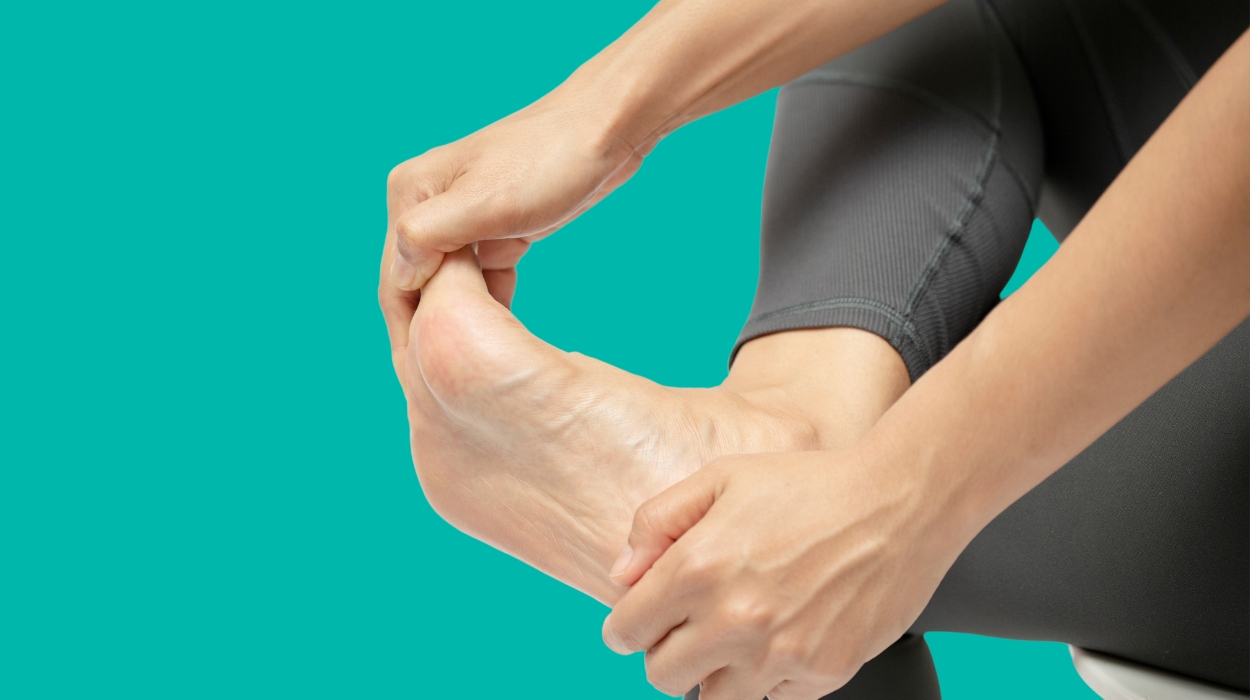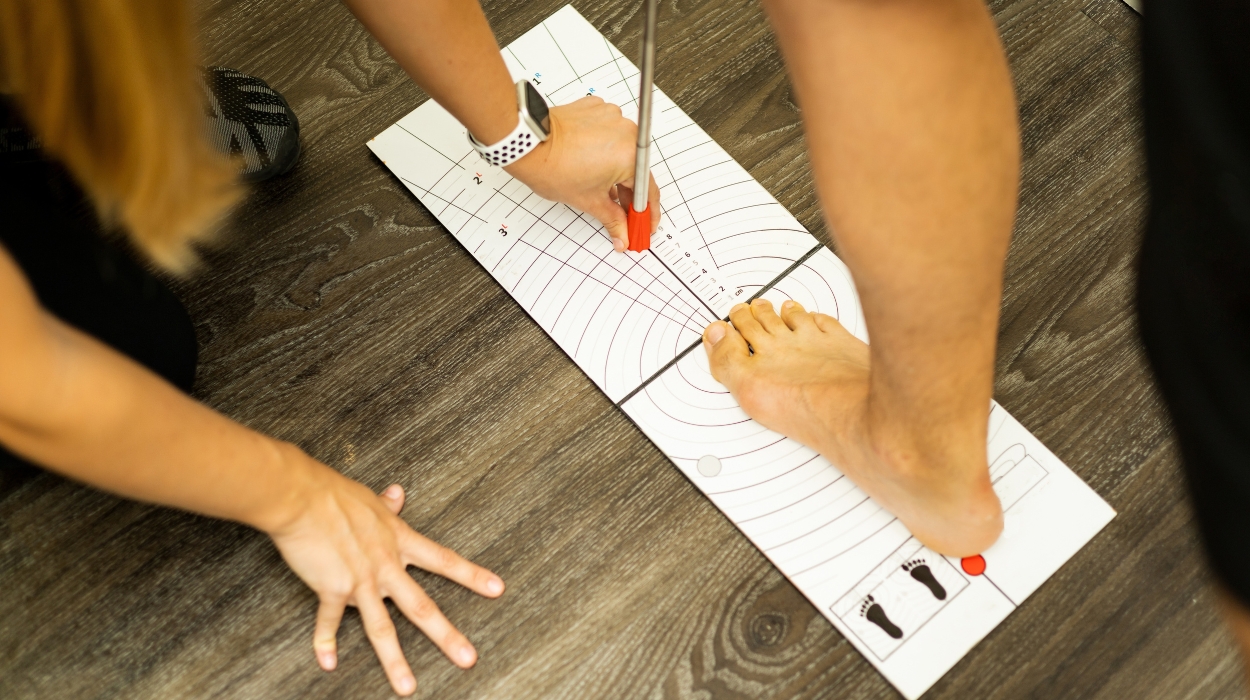 Expert's opinion
Expert's opinion
Expert's opinion
The article is a subjective view on this topic written by writers specializing in medical writing.
It may reflect on a personal journey surrounding struggles with an illness or medical condition, involve product comparisons, diet considerations, or other health-related opinions.
Although the view is entirely that of the writer, it is based on academic experiences and scientific research they have conducted; it is fact-checked by a team of degreed medical experts, and validated by sources attached to the article.
The numbers in parenthesis (1,2,3) will take you to clickable links to related scientific papers.
Dorsiflexion: How to Improve Flexibility In the Foot & Ankle 2024

Dorsiflexion of the ankle and foot refers to the freedom with which you’re able to lift your toes to meet your shinbones from rest. It’s a simple move, but the quality of this flexed state has a lot to do with the health of the feet, ankles, and lower leg.
Does a limited dorsiflexion range of motion put you at risk? Here are a few things you should know about this extremely important, weight-bearing system of muscles and connective tissues and how you can put your own ability to dorsiflex to the ultimate test.
What Is Dorsiflexion?
Dorsiflexion is a word that can be applied to both hands and feet—it’s a measure of how far the hand or the foot can bend before your range of motion has been maximized, or the ligament simply fails. Knee flexion is analogous to this concept, describing the leg’s range of motion at the knee.
What Is The Limit Of Your Dorsiflexion?

When you reach your upper limit in ankle dorsiflexion, you’ll feel muscle tightness that prevents the extremity from continuing; in the case of the hand, the movement will be backward, but in terms of ankle mobility, this will be determined by how close to the shin your toes can reach.
The deep peroneal nerve is the nerve responsible for pulling the foot upward by way of the peroneus longus.[1]
Movement contained in this system of bones, joints, and ligaments is called plantar flexion. Ankle joint equinus refers to the condition of limited ankle dorsiflexion range in this part of the body through any of a number of problems.
What Types Of Issues Limit Dorsiflexion?
There are many possible causes of an impaired ankle dorsiflexion range:
- Flat feet
- Tight calves
- Ankle injuries, and ankle sprains, sometimes as a result of previous physical activity
- Plantar fasciitis, inflammation[2] of the plantar fascia ligament
- Genetics
- A tight joint capsule, also known as a tight posterior ligament
- Arthritis
- Scar tissue impeding the motion of the ankle or front knee
- Carpal tunnel
- Foot or ankle surgery
- Training barefoot
Do You Have A Weak Dorsiflexion?
If you’re concerned that you might be suffering from joint restriction dorsiflexion problems, be on the look-out for these[3] tell-tale symptoms:
- A limited range of motion in the heel, toes, back leg, and ankles
- A limit in the directions and angle at which you can move your foot
- Excessive pressure and more stress on the forefoot
- Difficulty walking
- Abnormal, irregular, eccentric, or asymmetrical gait
- Ankle pain and foot pain
- A predisposition for other injuries in the area
- The development of shin pain and shin splints
If your degree of motion is limited because of an injury, it usually won’t be difficult to tell and to later test, usually by trying to pull the foot upwards. We advise against pushing anything that feels like a risk factor too far beyond its limit for your own safety.
If you experience sharp, unusual pain when either ankle is flexed, you should investigate the injury under the guidance of a doctor or a sports physical therapy expert.
What Is Considered Normal, Functioning Dorsiflexion?

If you can dorsiflex naturally between 0 degrees to 16.5 degrees[4] without feeling your muscles tighten from a neutral position, your dorsiflexion range of motion and the connective tissue that allows for it is within a healthy, normal range. If you can’t, you’re either utilizing the wrong technique or struggling with something that limits dorsiflexion in this area.
To self-diagnose your degree of attainable motion in your ankles, you can try a couple of different exercises. While sitting, you can draw your big toe up by contracting your shin. You can also try lifting the balls of your feet off of the ground while standing, as well, without lifting your heels off of the ground.
How To Improve Dorsiflexion In The Foot And Ankle
How is dorsiflexion improved? The good news is that you have plenty of options. Improving your muscle strength throughout the lower extremities will be of some importance, but there are actually many different factors and systems that determine the performance of the muscles, joints, and ligaments that affect your ability to dorsiflex comfortably.
Static Standing
The most common way to improve ankle dorsiflexion motion: is static stretching. Static stretching simply means assuming an extended position and holding the position[5] for a given amount of time – 60 seconds, for example. This is only one approach to relieving ankle joint restriction, however.
Gastrocnemius Stretching
Gastrocnemius stretching targets the soleus muscle. Stretch standing, facing a wall at arm’s length. With both palms flat against the wall, lean into its support while bending both knees, favoring one. Hold this weight-bearing position for one minute, and repeat on the other side.
You should feel the burn in your ankles and calf muscles as your body weight pushes them beyond their natural position—maintain a rigid stance as you stretch these muscle groups, with feet flat on the ground.
Gastrocnemius stretch routines tend to be especially effective when the goal is increasing one’s dorsiflexion range of motion. This cohort of young athletes[6] was able to improve ankle joint dorsiflexion through routine gastrocnemius stretching throughout the basketball season.
Other Strategies
You can also improve poor dorsiflexion through these strategies, as well:
- Heel raise exercises
- Running and stretching[7]
- Superficial heat therapy
- Diathermy therapy
- The application of ice
- Myofascial release therapy
- Better, more supportive shoes
- Improving your walking and running form
- Fitness supplements
How To Improve Knee Flexion
Some evidence also suggests that improving knee flexion may confer some benefit[8] to your ankle range. The body is a holistic system, which means that every interrelated system has some influence over the health of other joints and the normal movement that they’re all capable of.
To improve knee flexion, you can try this simple exercise:[9]
- Step 1: Lie on your back on a bed, facing the ceiling
- Step 2: Wrap the foot of your dominant leg with a towel or a belt, allowing you to pull it back toward your chest gently
- Step 3: Use one hand to hold the top of the leg down
- Step 4: Stretch the foot back toward you while keeping the leg straight and hold for thirty seconds
- Step 5: Repeat with the other leg, alternating anywhere from five to ten reps
- Step 6: Perform this exercise in its entirety up to three times a day
This exercise for limited dorsiflexion will be able to improve the entire kinetic chain of both legs. It takes little time, and people of all ages and fitness levels should be able to handle it, even if they’re already struggling with a limited ankle dorsiflexion range.
Has Limited Dorsiflexion Caused You Undue Pain?
The body is a system that works together. Give your ankles the relief they deserve with any of these ankle dorsiflexion tips for success.
Once your ankles and feet are in order, you’ll be feeling the love in your knees. Soon, this effect will eventually reach the shoulders. After that? Even the hip.
Before you know it, you’ll be out of your chair and primed to take on the world, all thanks to your newfound and vastly improved mobility.
+ 9 sources
Health Canal avoids using tertiary references. We have strict sourcing guidelines and rely on peer-reviewed studies, academic researches from medical associations and institutions. To ensure the accuracy of articles in Health Canal, you can read more about the editorial process here
- Baima, J. and Krivickas, L.S. (2008). Evaluation and treatment of peroneal neuropathy. Current Reviews in Musculoskeletal Medicine, [online] 1(2), pp.147–153. doi:https://doi.org/10.1007/s12178-008-9023-6.
- Tahririan, M.A., Motififard, M., Tahmasebi, M.N. and Siavashi, B. (2012). Plantar fasciitis. Journal of research in medical sciences : the official journal of Isfahan University of Medical Sciences, [online] 17(8), pp.799–804. Available at: https://www.ncbi.nlm.nih.gov/pmc/articles/PMC3687890/.
- Static Ankle Joint Equinus. (2010). Journal of the American Podiatric Medical Association, [online] 100(3), pp.195–203. doi:https://doi.org/10.7547/1000195.
- Baggett, B.D. and Young, G.P. (1993). Ankle joint dorsiflexion. Establishment of a normal range. Journal of the American Podiatric Medical Association, [online] 83(5), pp.251–254. doi:https://doi.org/10.7547/87507315-83-5-251.
- Young, R., Nix, S., Wholohan, A., Bradhurst, R. and Reed, L. (2013). Interventions for increasing ankle joint dorsiflexion: a systematic review and meta-analysis. Journal of Foot and Ankle Research, [online] 6(1). doi:https://doi.org/10.1186/1757-1146-6-46.
- Knapik, D.M., LaTulip, S.M., Salata, M.J., Voos, J.E. and Liu, R.W. (2019). Impact of Routine Gastrocnemius Stretching on Ankle Dorsiflexion Flexibility and Injury Rates in High School Basketball Athletes. Orthopaedic Journal of Sports Medicine, [online] 7(4), p.232596711983677-232596711983677. doi:https://doi.org/10.1177/2325967119836774.
- McNair, P. and Stanley, S.N. (1996). Effect of passive stretching and jogging on the series elastic muscle stiffness and range of motion of the ankle joint. British Journal of Sports Medicine, [online] 30(4), pp.313–317. doi:https://doi.org/10.1136/bjsm.30.4.313.
- Fong, C.-M., J. Troy Blackburn, Norcross, M.F., McGrath, M.L. and Padua, D.A. (2011). Ankle-Dorsiflexion Range of Motion and Landing Biomechanics. Journal of Athletic Training, [online] 46(1), pp.5–10. doi:https://doi.org/10.4085/1062-6050-46.1.5.
- Shelbourne, K.D., Biggs, A. and Gray, T. (2007). Deconditioned Knee: The Effectiveness of a Rehabilitation Program that Restores Normal Knee Motion to Improve Symptoms and Function. North American journal of sports physical therapy : NAJSPT, [online] 2(2), pp.81–9. Available at: https://www.ncbi.nlm.nih.gov/pmc/articles/PMC2953293/.



